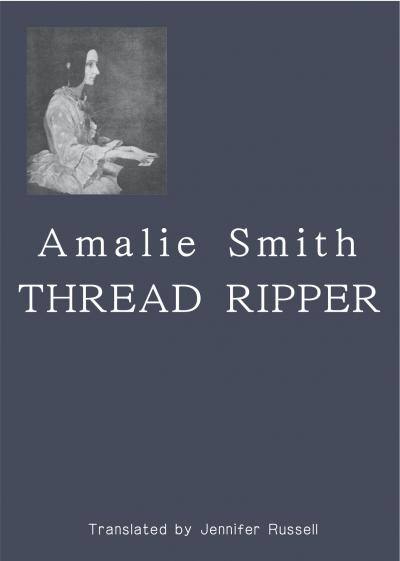Sitting in the park on a hot summer’s day, life began to imitate art. I had been soaking up the sun’s now overpowering rays for over an hour and was beginning to feel its radiating effects.
Golden green filaments of grass moved back, the trees swayed in heady sympathetic succession; buzzing from the outside in, my body started to metabolise light at a speed my brain couldn’t fathom. My skin bubbled green, my tongue unfurled petals and my eyes sprouted luminous buds. I had become a plant – or so I felt – and the sun-soaked synthesis of my transformation was near complete.
Hyperbole, you wonder? Except this is exactly what happens in Amalie Smith’s superlative double-stranded novel, Thread Ripper, translated from the Danish by Jennifer Russell. Seemingly teleported via Google Maps, Smith’s auto-narrator finds herself in a Japanese atomic garden. Having read that nuclear radiation destabilises the DNA of plants, “like smashing genes with a hammer”, causing significant changes to their biological structures and appearance, the narrator undergoes a similar, radical destabilisation. Of course, this is Smith pointing to the atomic power of the imagination, the interconnections of plant and animal and digital life, the sublime annihilation of “fixed” categories and, indeed, of fixity itself. Like the mutating plants the auto-narrator muses on, Smith’s dyadic novel radiates a force-field of energy, morphing under the heat of our gaze only to reassemble itself, radium-like, before the mind’s eye.
 That’s not to say Thread Ripper is purely about plant life, park life or the kind of life that fizzes and fuses in petri dishes or around derelict nuclear grounds. No, it’s so much more capacious and exquisitely crafted than that. Rather, the fabric of life – and art – is Smith’s focus; the beautifully subtle threads between thought and matter, nature and culture, man and machine, myth and history, the neural and the digital are the substance through which she weaves this exceptional book. By creating a novel that challenges binaries and looks to her own hybrid position of artist-cum-author, Smith actively demonstrates the potential of narrative, the possibilities of the (art)book form, the future of texts and textuality.
That’s not to say Thread Ripper is purely about plant life, park life or the kind of life that fizzes and fuses in petri dishes or around derelict nuclear grounds. No, it’s so much more capacious and exquisitely crafted than that. Rather, the fabric of life – and art – is Smith’s focus; the beautifully subtle threads between thought and matter, nature and culture, man and machine, myth and history, the neural and the digital are the substance through which she weaves this exceptional book. By creating a novel that challenges binaries and looks to her own hybrid position of artist-cum-author, Smith actively demonstrates the potential of narrative, the possibilities of the (art)book form, the future of texts and textuality.
Yet it’s the intertextual she starts with, and the polyvalent texture of writing – or rather, words and their etymological histories – that she enjoys unravelling while weaving her novel. We begin not with the atomising artist-author in Japan, but several years prior, when the narrator is alone in a cabin surrounded by dense forest, identifying with the weaver of all weavers, Penelope, of Greek mythology (Homer, Apollodorus). Commonly praised for her devotion to the adventurer Odysseus, Penelope is invoked here not so much for her fidelity to her husband, but rather her ambivalence towards him – that is, her “wavering”, wondering, weaving state. Sat at her loom to ward off the 108 suitors who have run amok at the palace in Odysseus’ absence, Penelope weaves a shroud for her father-in-law, King Laertes, unpicking it at night, only to resume weaving by day. It is craft as a form of protection, deflection and implicit insurrection. Smith knows this, so much so that in citing and threading the mythical figure into the warp and weft of her own double-stranded narrative, she brings a quietly anarchic feminine force to the fore.
Like Penelope, the narrator wavers in the threads of her own life – often at a deliberate distance from her lover. A thirty-something artist, commissioned to create computer-generated tapestries of organic impressions – the art of nature meets the nature of art again – Smith’s narrator looks to Penelope in her artful musings, only to move away from her when reaching for more advanced technological and poetical modes of expression. No longer the one being narrated, but narrating, Smith’s protagonist, in her “wavering” state, plucks on the strings of longing in superb imagistic and stanzaic strands of poetry, beautifully captured by Jennifer Russell’s translation. Unable to create a coherent image like Penelope, Smith’s weaver instead offers up a glorious glut of impressions, Google-style, across the seven sections: steel-blue beetles, kicked mushrooms, dark wet soil, fog, a spider’s web.
But invoking Penelope in the typed notes of her text (the other strand) creates a snag in the textured sequencing of the novel. Though we’re invited to unravel and re-thread the dyadic narrative in any fashion we so desire, Smith’s weaver-narrator moves us back and forth in time, creating holographic parallels, ripples, reflections, and spectral recurrences across the double-paged strands. Time is therefore folded, collapsing in on itself only to unfold again across a new space, text and type. Smith sets up a deceptively linear progression for the design and development of her technicolour tapestry created in Tillburg via a computerised Jacquard loom alongside the history of weaving itself (older than writing we’re told), which encompasses silk worms, moths, the air-looms of madmen, the manual looms of Luddites, the Punch-card looms of Jacquard, the “Analytical Engine” of Charles Babbage and the first computers of the 20th century. Weaving, then, whether it takes the form of text, textiles or tissue (all verb forms which derive from the Latin texere), proves to be a radical act of resistance.
 There are also the phantoms in this threaded web, ghosts in the shell, or rather, the digital realms of which they’d once dreamed. Mathematician and computer pioneer Ada Lovelace, a weaver of numbers and a second narrator of a kind, comes to life in the second strand of the novel through her epistolary algorithmic iteration. Feeding Ada’s letters into an algorithm, the narrator sees Ada eerily echoing her own frustration and creative yearning back to her (it will be Ada’s name the narrator assumes during her sojourn in Japan). AI-Ada voices the automated dreams of 19th century epistolary Ada: from flying steam-powered horses, the neural networks of machines and the fusion of poetry and philosophy to her annoyance at the narrow visions of Babbage, her husband William, and the whole man-made system she notates and sees beyond.
There are also the phantoms in this threaded web, ghosts in the shell, or rather, the digital realms of which they’d once dreamed. Mathematician and computer pioneer Ada Lovelace, a weaver of numbers and a second narrator of a kind, comes to life in the second strand of the novel through her epistolary algorithmic iteration. Feeding Ada’s letters into an algorithm, the narrator sees Ada eerily echoing her own frustration and creative yearning back to her (it will be Ada’s name the narrator assumes during her sojourn in Japan). AI-Ada voices the automated dreams of 19th century epistolary Ada: from flying steam-powered horses, the neural networks of machines and the fusion of poetry and philosophy to her annoyance at the narrow visions of Babbage, her husband William, and the whole man-made system she notates and sees beyond.
Yet all threaded things – whether computer networks, neural systems or loom-woven tapestries – inevitably succumb to bugs of some kind. The final strands of Smith’s novel take us back to the moth and rust of it all: back to the first bug found by Grace Hopper in the Mark II computer in 1947, through to the dystopian plague of moths ravaging Penelope’s “hyper-loom” of 2030. We return – or fast-forward – to the interlacing of machine and matter, moth and modem, the wavering weave of life’s interminable decay despite the preservative methods of digitisation. Taking us back to the influence of radiation, entropy, doubt, death and decay, Smith’s narrator demonstrates that all is one in the moving fabric of life, the cogs and wheels of the cosmos, and still such fragile threads all too easily rip.
Thread Ripper is, in its impressive hybridity of art and life, one of the most daring novels I’ve read to date. It’s a book that looms high over others and dares to waver in ways future texts can only dream of imitating.
- Thread Ripper by Amalie Smith, translated by Jennifer Russell (Lolli Editions, £12.99)
- More book reviews on theartsdesk















Add comment